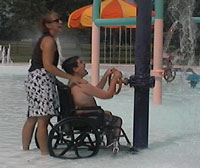by Susan Ostby and Jennifer Skulski
 |
| JC and his mom play in the water spray pool at Riverside Park Aquatic Center in Indianapolis. |
Swimming offers physical, mental, and social benefits to people of all ages and abilities. Consider the diversity the pool has to offer. A child can strengthen muscles and develop lung capacity with a game spent diving for coins or other sunken treasures. A CEO may use his lunch break to swim some laps for cardio benefits as well as a refreshing break from the corporate jungle. A woman in her 50's or 60's may choose a water aerobics class for conditioning exercise that has little to no impact on her joints. A high school student may join the swim team for the competition, physical activity, and opportunity to build new friendships. It's no wonder that swimming consistently ranks as one of the more popular recreational activities in the United States.
The following monograph discusses some of the major considerations for the successful inclusion of people with disabilities at aquatic facilities, including visitor expectations, accessibility guidelines for swimming pools, considerations for aquatic staff, policies and procedures, family restrooms, pool lifts, aquatic chairs, and water slides.

